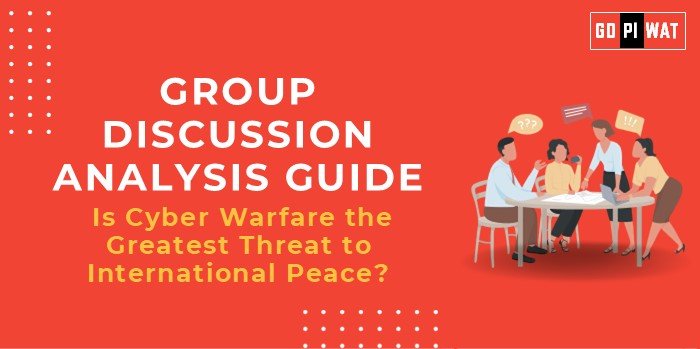📋 Group Discussion (GD) Analysis Guide
🌟 Is Cyber Warfare the Greatest Threat to International Peace?
🌐 Introduction to Cyber Warfare
Opening Context: In an increasingly digital world, cyber warfare has emerged as a potent and disruptive force, capable of destabilizing nations, economies, and societies. Its relevance has grown as international actors exploit digital tools for strategic and malicious purposes.
Topic Background: The roots of cyber warfare can be traced to the early 2000s with notable incidents such as the Estonia cyberattacks in 2007. These acts, often attributed to state and non-state actors, underline the shift in modern warfare from physical confrontations to digital battlegrounds. Recent events, including attacks on critical infrastructure, underscore its potential to jeopardize international peace.
📊 Quick Facts and Key Statistics
- 💻 Cyberattacks on Critical Infrastructure: Over 75% of reported incidents in 2023 targeted energy, healthcare, and communication systems.
- 💰 Global Cybersecurity Spending: $188 billion projected in 2024, reflecting growing concern among nations.
- 🔒 Ransomware Damages: Estimated to exceed $30 billion globally in 2023.
- ❓ Attribution Dilemma: Over 60% of cyberattacks remain unattributed due to sophisticated obfuscation techniques.
👥 Stakeholders and Their Roles
- 🏛️ Governments: Develop cybersecurity policies and deploy cyber defenses; often accused of sponsoring offensive cyber operations.
- 🏢 Private Sector: Key providers of infrastructure and innovation, making them both targets and defenders.
- 🌐 International Organizations: Institutions like the UN advocate for frameworks to regulate cyber conflict.
- 👥 Citizens: Both vulnerable to cyberattacks and participants through inadvertent actions (e.g., phishing susceptibility).
🏆 Achievements and Challenges
- 🎯 Achievements:
- Resilience Measures: Enhanced security in sectors like finance, with reduced incidents due to improved protocols.
- International Cooperation: Initiatives like the Paris Call for Trust and Security in Cyberspace.
- Technological Innovations: AI in threat detection significantly reduces response time.
- ⚠️ Challenges:
- Attribution and Accountability: Difficulty identifying attackers undermines deterrence.
- Lack of Global Consensus: Nations disagree on rules of engagement for cyber warfare.
- Resource Disparity: Developing nations lag in cyber defense capabilities, increasing global vulnerability.
🌍 Global Comparisons
- 🌟 Estonia’s Cyber Defense League: A model of integrated national cyber resilience.
- ⚔️ Russia-Ukraine Cyber Conflict: A showcase of cyber warfare’s role in hybrid conflicts.
Case Study: AIIMS Cyber Attack (2022): Disruption in India’s healthcare systems exposed vulnerabilities in critical sectors.
📋 Structured Arguments for Discussion
- ✔️ Supporting Stance: “Cyber warfare’s low cost, anonymity, and global reach make it the most formidable threat to peace today.”
- ❌ Opposing Stance: “Traditional threats like nuclear proliferation and territorial disputes still overshadow the risks of cyber warfare.”
- ⚖️ Balanced Perspective: “While cyber warfare poses unique risks, it complements rather than replaces traditional threats to international peace.”
🛠️ Effective Discussion Approaches
- 🔍 Opening Approaches:
- Statistical Impact: “Ransomware damages surpassed $30 billion globally in 2023, a stark indicator of rising cyber threats.”
- Case Study: “The 2022 AIIMS cyberattack in India disrupted healthcare services for weeks.”
- Global Comparison: “Estonia’s resilience contrasts starkly with vulnerabilities in many developing nations.”
- 💬 Counter-Argument Handling:
- Acknowledge traditional threats’ persistence but highlight cyber warfare’s evolving sophistication and low barriers to entry.
📈 Strategic Analysis of Strengths and Weaknesses
- 🟢 Strengths:
- Anonymity and deniability enable stealth operations.
- Disruptive potential in critical systems (e.g., energy grids).
- 🟡 Weaknesses:
- Attribution challenges dilute deterrence.
- High dependence on digital infrastructure creates mutual vulnerabilities.
- 🔵 Opportunities:
- Global treaties to regulate cyber warfare.
- Technological advances in AI-driven defense systems.
- 🔴 Threats:
- Escalation risks from misattributed or retaliatory actions.
- Undermining trust in digital systems globally.
📚 Connecting with B-School Applications
- 🌏 Real-World Applications: Research in cybersecurity frameworks, blockchain for secure data sharing, and ethical AI practices.
- 🤔 Sample Interview Questions:
- “How can businesses safeguard against cyber warfare impacts?”
- “Evaluate the role of international alliances in mitigating cyber threats.”
- 💡 Insights for Students:
- Cybersecurity as a strategic imperative in operations management.
- Leadership roles in fostering digital trust and resilience.


